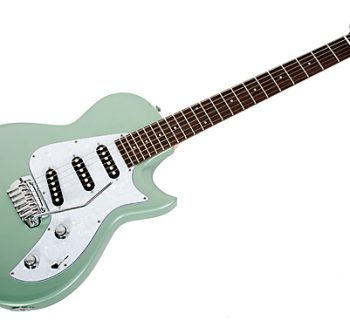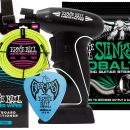 A great set of cans is essential whether you spend a lot of time in the studio or play drums live to a click-track. A relative newcomer to the professional headphone space, Shure has taken their expertise with in-ear monitoring and microphones and applied it to this essential area of sound reproduction. The results are nothing short of fabulous, with two sets of headphones that each deliver exactly what you need: great sound, sumptuous comfort, fantastic sound isolation, and no ear fatigue!
A great set of cans is essential whether you spend a lot of time in the studio or play drums live to a click-track. A relative newcomer to the professional headphone space, Shure has taken their expertise with in-ear monitoring and microphones and applied it to this essential area of sound reproduction. The results are nothing short of fabulous, with two sets of headphones that each deliver exactly what you need: great sound, sumptuous comfort, fantastic sound isolation, and no ear fatigue!
Historically, engineers shied away from headphones for mixing because they couldn’t deliver accurate-enough sound reproduction across a wide-enough frequency spectrum. But advances in the use of neodymium magnets have taken headphone audio quality to previously unachievable levels of reproduction accuracy.
Today, you’ll find plenty of engineers mixing projects completely in-the-box on their laptops, and tiny ear buds just won’t cut it for this type of work. Additionally, good headphones in the studio make a great supplement to your monitors, as they can help you evaluate stereo separation and overall balance in your mixes, and sometimes hear things that you missed in the big speakers.
Great headphones are also essential for great tracking. Uncomfortable headphones that can’t deliver a clean sound, loud mix, and minimal bleed are useless to a drummer, for example, and will not inspire a great performance.
Whether on stage, tracking in the studio, or mixing, we found nothing but praise for these Shure headphones. The SRH840 is easily our top choice for the studio — for both tracking and mixing, while the less expensive SRH440 (a steal at $99 street) is the headphone we’ll share with other musicians for tracking. And did we even mention how great these headphones are for tuning out the world and just listening to music?
Features
| SRH840 | SRH440 |
The SRH840 and SRH440 share many attributes including a 40mm neodymium magnet, but while the SRH440 has a frequency range of 10 Hz – 22 kHz, the SRH840 features an extended range of 5 Hz – 25 kHz.
Each set of headphones is capable of handling high SPLs, and while the SRH440 can handle 500 mW of input power, the SRH840 can handle 1000 mW. Either set of headphones will accommodate tracking a loud drummer.
Both headphones are closed-back models with circumaural, padded earpieces that are slightly oval in shape (to more ergonomically fit the contours of your ears). The headbands are padded, with the SRH840 having a moisture-wicking layer added to the underside of the band.
The headphones have lockable, detachable, 3-meter coiled cords with 1/8” gold-plated connectors on the end, plus they include gold-plated 1/8” – 1/4" adaptors that securely screw into the end of the cable.
Both headphones include a soft carrying bag, and the SRH840 also includes a spare set of ear pads.
| SRH840 | SRH440 |
These headphones were both extremely comfortable to wear for extended periods of time, and we’ve already logged many hours tracking and mixing with them. They each received praise from everyone who used them.
The detachable cable mechanism is great, as headphone cables routinely get trashed from wear-and-tear in an active tracking environment.
If the SRH440 headphones are very comfortable to wear, then the SRH840 are truly sumptuous. The ear pads feel like they have slightly more padding, and the wicking moisture band across the inside of the headband makes them sit even softer across the top of our head (the SRH440 is also padded across the headband).

These differences in feel are very subtle and not a big deal at the end of the day. It would be inappropriate to rate the SRH440 with half a star less since we’re splitting hairs, talking about the difference between feeling great and super-great.
Many premium headphones deliver what is known as hearing fatigue, just like some studio monitors. Listening to them for extended periods of time can lead to headaches or just an unpleasant, unsettled discomfort. Part of the joy in keeping these Shure headphones on our heads was that they were not fatiguing. We never felt like we needed a break from listening/tracking in these headphones due to hearing fatigue.
Musicians tracking with the SRH440 were very happy with how loud and clean a reference mix they could hear while tracking, and the sound isolation was really fantastic, even for tracking in the same room with guitar amps and drums.
The headphones can be flipped over for handholding a single earpiece to the head, and we found that Shure’s design was less flimsy than some other headphones we’ve relied upon in the past.
For dedicated mixing sessions, we’d love to see a new headphone based on the SRH840 but featuring an open-back design to allow for some bleed from one ear to the other (audio signal bleed — not our ear drums!). However, if you like to mix in public, the closed-back design will prove more beneficial. Plus, you can pull double-duty with this design, using the headphones for tracking as well as mixing.
Sound
| SRH840 | SRH440 |
Both sets of headphones sound great, but for mixing and other critical listening tasks, the SRH840 slightly outperform the SRH440 cans. There was a little bit more “air,” or high end presence noticeable at the top end, while the extra few Hz of low-end frequencies let us hear more definition in the bottom end.
We found there to be a slightly different EQ curve to these headphones. Perhaps the difference is that the SRH840 headphones are more flat while the SRH440 are more hyped with a typical u-shaped EQ curve (boosting the bottom and the top), but besides the air up top in the SRH840, we also had an easier time hearing mid-range frequencies that were less obvious (or non-existent) in the SRH440 (perhaps masked by the boosted bass frequencies).
Regardless, even the less costly SRH440 are a welcome improvement over the popular “digital” headphones we’ve used in our studio for years, and the lack of hearing fatigue alone was reason enough for us to never want to use the old headphones again.
We wouldn’t advise mixing an entire record with any headphones, though. You’re likely to give yourself some hearing damage from constant, loud music pumped straight into your head, but to go from tracking to mix evaluation as well as location-based recording, the SRH840 just sound great overall.
Documentation and Product Support
| SRH840 | SRH440 |
If you’re not sure how to operate a familiar set of headphones, we don’t even have a tutorial on that subject, but fear not, because the headphones include an owner’s manual that instructs you in the basics of their use, the audio specs, and their care. (If you picked yours up second-hand on eBay, or hate reading manuals, note that a damp cloth is all it takes to wipe them down).
Price
| SRH840 | SRH440 |
The Shure SRH440 (MSRP $125) sells for $100.
The Shure SRH840 (MSRP $250) sells for $200.
While the SRH440 is an obvious steal, the SRH840 is also priced very competitively for a professional mix-friendly headphone. We’ve paid far more for headphones that sounded far worse and weren’t nearly as comfortable. Both of these review units have found new homes in our studio.
Shure’s headphone family also includes a less expensive headphone for general purpose use, as well as another model specific for DJ applications.
Contact Information
Shure Inc.
www.shure.com

















